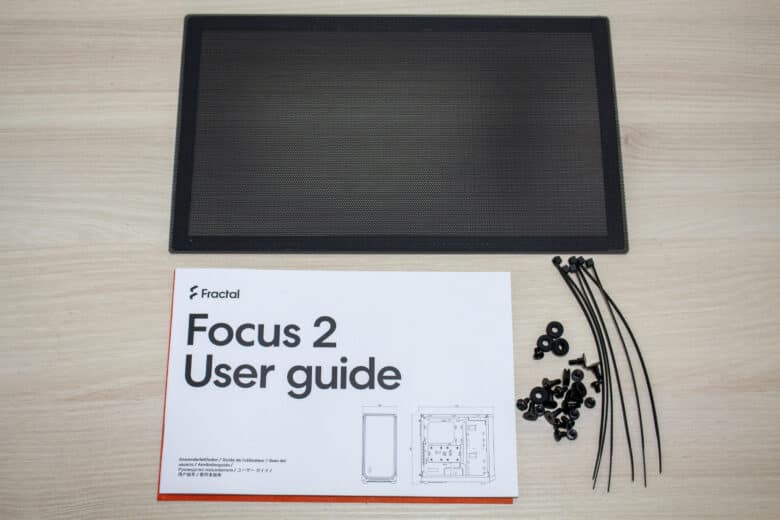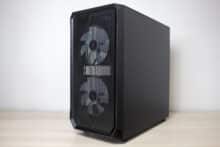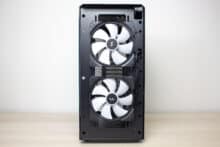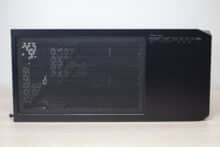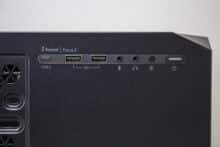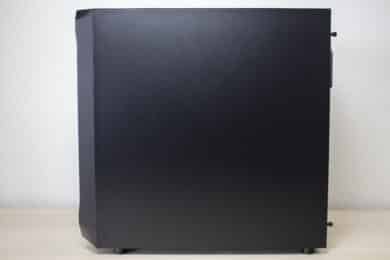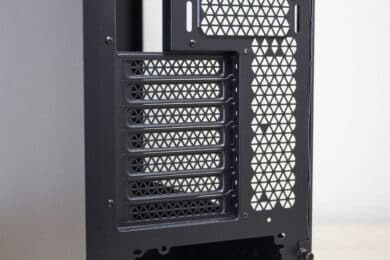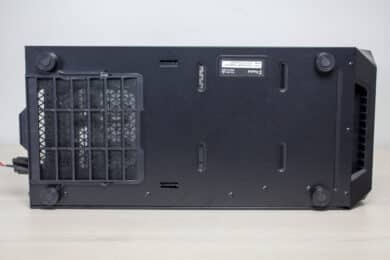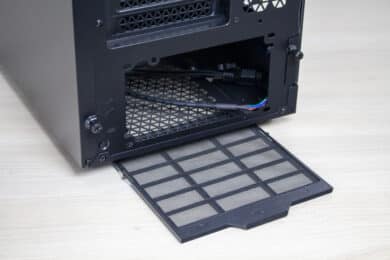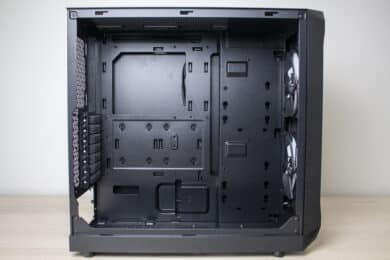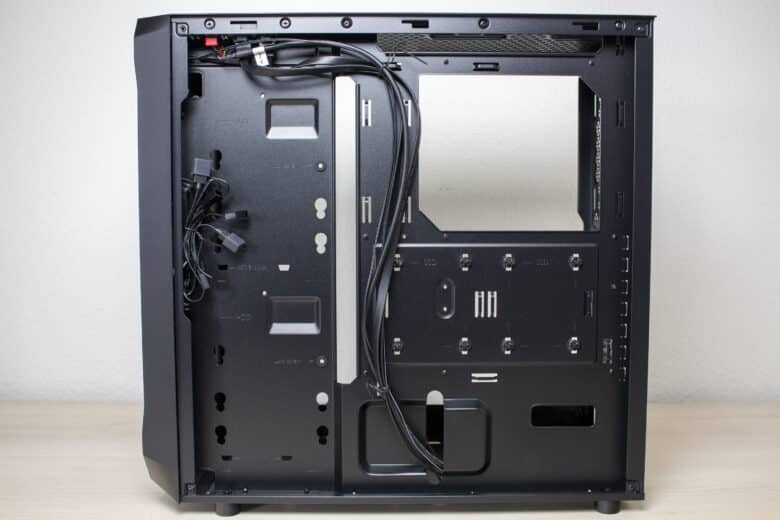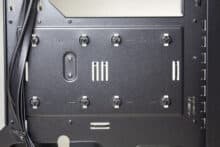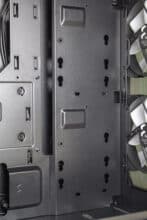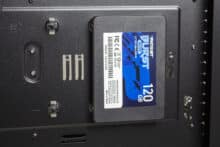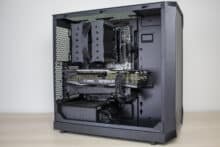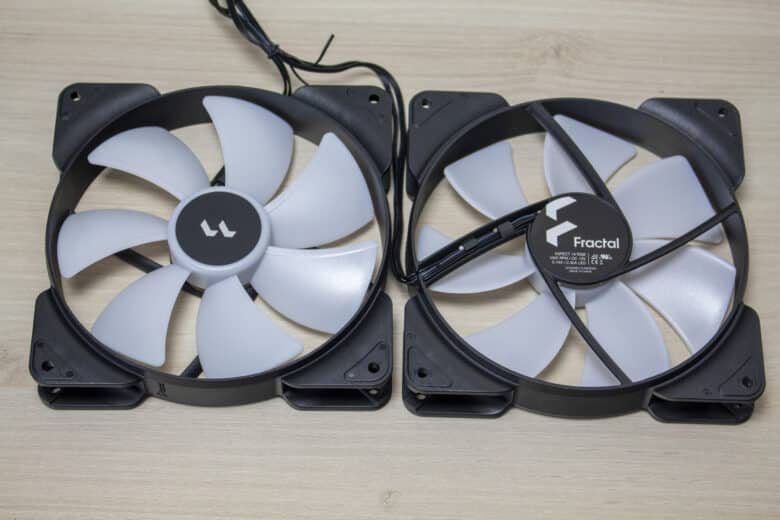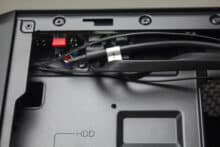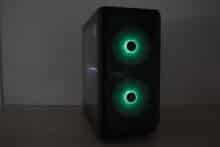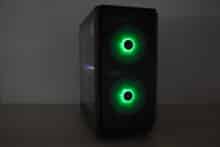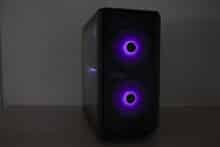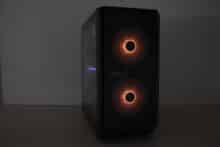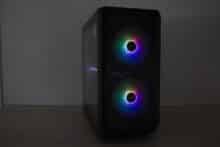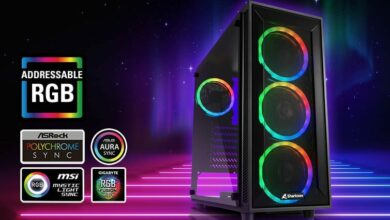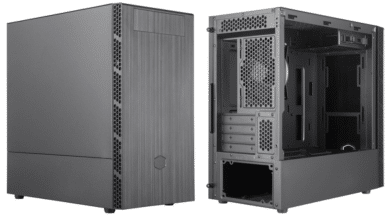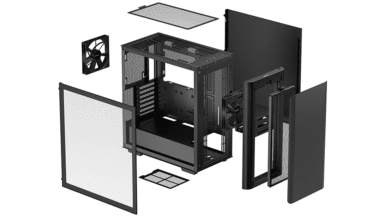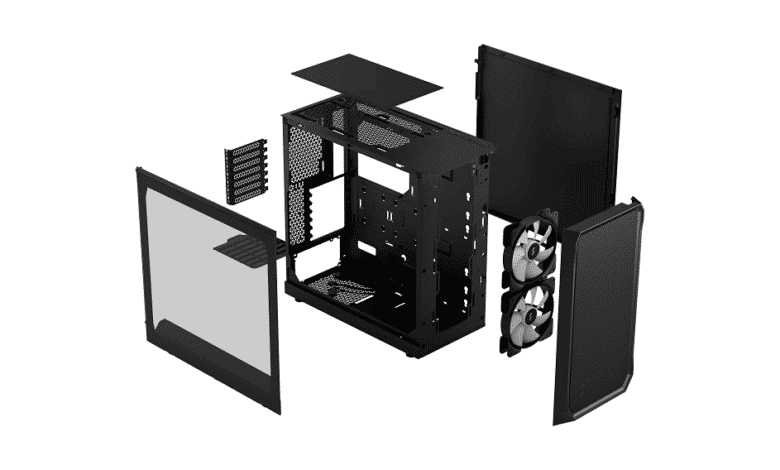
The manufacturer Fractal Design has long been an integral part of the case market. Even though mesh and RGB elements have now made it into the product range, most of the manufacturer’s towers are predominantly timeless and simple in design. In August 2022, Fractal Design then presented numerous case updates. Among the updates is a new version of the Focus G. The successor goes by the name Focus 2 and focuses, at least on paper, on the essential features that a case has to bring along.
In addition to generous space, two pre-installed fans and a solid build quality, the manufacturer claims that a good airflow and a retrofittable I/O panel are among the positive features of this midi tower. Fractal Design offers the Focus 2 in a total of five variants. Besides three black versions (Solid Black, Tempered Glass, Tempered Glass + RGB), there are also two white versions (Tempered Glass, Tempered Glass + RGB). Today, we are testing the Focus 2 RGB Black TG variant with a viewing window and two pre-installed ARGB fans. The Focus 2 starts at €69.90 (RRP). Our version retails for €79.90 (MSRP).
Technical details
| Model: | Fractal Design Focus 2 RGB TG |
| Case Type: | ATX |
| Dimensions: | 215 mm (W) x 450.5 mm (H) x 471.5 mm (D) |
| Weight: | 6.1 kg |
| Material: | Steel, plastic |
| Color: | Black |
| Front connectors | 2x USB 3.0 Type-A, 1x headphone, 1x microphone |
| Drive bays: | 6x 2.5″ (2 included) 2x 3.5″ (2 included) |
| Expansion slots: | 7x horizontal |
| Form Factors: | ATX, mATX, ITX |
| Ventilation: | Front: 3x 120/ 2x 140 mm Rear: 1x 120 mm Lid: 2x 120 / 140mm |
| Radiators: | Front: 1x 240/ 280/ 360 mm Rear: 1x 120 mm Lid: 1x 240 mm (max. 46 mm height of motherboard components) |
| Max. CPU cooler height: | 170 mm |
| Max. Graphics card length: | 340 mm (without AiO water cooling in the front) |
| Max. PSU length: | 250 mm (max 175 recommended) |
| Cable management space: | 19 mm |
| Price: | € 86.49 * |
| Features: | Dust filter, cable management, 2 pre-installed ARGB 140mm fans including control board |


Scope of delivery
Like many other manufacturers, Fractal Design does not use any extravagant colors or other design elements in the packaging. The cardboard box is brown and shows a schematic drawing of the Focus 2 as well as its technical specifications and key features. Inside the cardboard box, the Focus 2 is encased in two soft blocks of foam. Additionally, Fractal Design has wrapped the midi tower in a plastic film to protect the steel and plastic from unsightly scratches. Lastly, the side window was also covered with two films.
The manufacturer did not put the mounting accessories in a cardboard box, as usual, but in a simple plastic bag. Included there are some cable ties as well as all necessary mounting screws. Last but not least, the accessories include a detailed and illustrated user manual, as well as a magnetic dust filter for the lid.
Exterior impression
Externally, the Focus 2 keeps a very low profile when powered off and somewhat resembles the Meshify series. However, the large mesh front, which is surrounded by a solid frame made of plastic, is not “bulged” with a geometric pattern, but completely smooth. As a small hint to the manufacturer, the Fractal Design logo can be found in the lower left corner. The front panel can be removed with a strong jerk and reveals the two pre-installed fans. These have a frame width of 140 millimeters and feature ARGB lighting. Alternatively, three 120 mm fans can be mounted on the front. There is no additional dust filter here.
If you lift your gaze towards the lid section, you should immediately notice the very large fan grille on the top of the Focus 2. This offers mounting rails for two 120 or 140 mm fans as well as a 280 mm radiator. To improve the appearance, a magnetic mesh dust filter has been placed above the interestingly designed fan grille. The front area of the case lid is closed and houses the elongated I/O panel on the right side. Besides two USB 3.0 ports and two HD audio ports (microphone, headphone), you’ll find a power and reset/RGB button and a free space for an optional USB 3.2 Type-C port.
The left side panel of the Focus 2 is made of either a clear Tempered Glass or steel, depending on the model. It is locked in place with steel retaining lugs and corresponding eyelets on the body, as well as two thumbscrews on the back of the side panel. Furthermore, the side panel has an angled steel lip on the inside, which is supposed to serve as a kind of power supply cover. The right side panel is made of steel and has an acceptable material thickness. It is also mounted to the tower with retaining lugs and corresponding eyelets as well as two thumbscrews. For both side panels, the knurled screws remain on the side panel and can therefore not be lost.
The back of the Focus 2 is unspectacularly designed. Besides a mounting place for a 120 mm fan, seven reusable PCI slot panels and an additional ventilation opening can be seen. All grilles have the same design as the one in the lid. This makes for a chic and uniform look.
As usual, the power supply unit finds its place in the bottom area of the Focus 2 and sucks in filtered air from below.
This also brings us directly to the bottom of the midi tower. Besides the filtered power supply opening, there is not much here. The power supply filter is very finely designed and surrounded by a solid plastic frame. This facilitates the installation and removal for cleaning purposes immensely. Furthermore, the Focus 2 stands on four solid plastic feet, which have been covered with a layer of rubber to protect the base and reduce vibrations.
Interior impression
Inside the Focus 2, you can see that certain features have fallen victim to the red pen here. The most noticeable of these is the absence of a power supply cover. As a result, the interior is not divided into two chambers, but consists of a single large chamber. The lack of hard drive cages or unnecessary struts in the front area allows the two pre-installed case fans to freely move fresh air into the main chamber.
The manufacturer has designed the motherboard tray almost plan and punched various cable management openings into the tray around the ATX mounting points. In total, there are two elongated openings for the motherboard and a somewhat wider opening for the power supply. Unfortunately, there are no rubber sleeves on the Focus 2. But there is the obligatory cutout in the mainboard tray for CPU coolers with backplates. In the lower area the PSU rests on four small rubber buffers and in the front area there are four rails for mounting accessories (e.g. AGB for water cooling).
The back of the motherboard tray offers at least 19 millimeters of space for cables. This value is not exactly generously chosen and forces the buyer to take a bit more effort when laying the cables. Fractal Design has not skimped on eyelets for cable ties so that all cables can be neatly laid. Other than that, there’s not much else to see here besides the mounting spots for data media.
The Focus 2 offers enough space for data media. Ex works, the midi tower supports two 2.5″ SSDs and two 3.5″ HDDs. Mounting the 3.5″ data media requires tools and is done via rubber rings and special oblong screws. The hard drive is fixed parallel to the mainboard tray in the left area with these. The same applies to the smaller SSDs. However, the installation can be done without tools. Fractal Design has placed corresponding mounting shoes at the mounting points, onto which the SSDs simply have to be inserted.
Basically, the workmanship is on a very good level. The paint job on all components is decent and the material selection/feel are solid. However, if you consider the size of this tower and at the same time its weight, it quickly becomes clear that some thinner steel was used in some places. Fortunately, though, even without side panels, the Focus 2 is sturdy and doesn’t rattle.
System build in the Fractal Design Focus 2 RGB TG
Now we get to the system build. For hardware, we are using an Intel Core i5-12600K* on a MSI PRO Z690-A DDR5* with 32GB Kingston FURY Beast DDR5-4800*. The Core i5 is cooled by a Noctua NH-D15S chromax.black* and is not overclocked. The MSI GeForce RTX 3090 Ti Gaming X Trio 24G* is responsible for the image output. The power supply is handled by the fully modular be quiet! Straight Power 11 Platinum with 850W* with an 80 Plus Platinum efficiency rating.
The installation of all components was very easy and quickly done. Due to the pre-installed spacers as well as the huge main chamber, it was no problem to mount the motherboard even with the CPU cooler installed. However, it was a bit more difficult when it came to the cabling. The reason for this is mainly the rather compact cable management opening for the PSU and its positioning. Fractal Design recommends a maximum power supply with a length of 175 millimeters for a smooth installation and cabling. If the PSU is longer, then it completely covers the cable management opening and the cables can no longer be routed behind the motherboard tray.
Despite the lack of a PSU cover, the end result still looks pretty neat. The steel lip on the side window should also make the lower area barely noticeable. Visually, a non-modular PSU could probably even achieve a better result in the Focus 2. However, accommodating the superfluous cables behind the motherboard tray would be a bigger challenge. Especially if you still want to place 3.5″ data carriers on the back.
From the factory, the Fractal Design Focus 2 RGB TG comes with two pre-installed 140mm fans in the front. The fan series is new in the manufacturer’s portfolio and is called Aspect 14 RGB. The fans feature a black frame and white, but slightly milky, fan blades. The digitally addressable RGB LEDs are located in the fan hub. They are connected to the motherboard via a 5V 3-pin ARGB header for lighting or a 3-pin connector with Y-switch for power. The maximum speed of the fans is 1000 rpm. Even at maximum speed, the fans weren’t really obtrusive and there was no ambient noise to be heard.
Lastly, we come to the temperatures that were reached in the Fractal Design Focus 2 RGB TG. Due to the very power-hungry hardware, we unfortunately had to run several tests to get presentable values. During the stress test, Prime95 and FurMark were run for 15 minutes at a room temperature of approximately 26°C. In addition, the CPU was undervolted because the motherboard applied unnecessarily high voltages and overclocks ex works.
Scenario |
Temperature |
| CPU: 50% PWM (830 rpm) GPU: 50% PWM (1500 rpm) Front: 2x 140 mm on 100% (980 rpm) Undervolt CPU 0.04V offset |
CPU: 98 °C GPU: 90 °C (temperature limit, voltage reduced to 1965 MHz) |
| CPU: 50% PWM (830 rpm) GPU: 50% PWM (1500 rpm) front: 2x 140 mm on 100% (980 rpm) rear: 1x 120 mm rear on 100% (1500 rpm) Undervolt CPU 0.04V Offset |
CPU: 96 °C GPU: 90 °C (temperature limit, voltage reduced to 1965 MHz) |
| CPU: Auto (1500 rpm) GPU: Auto (2500 rpm) front: 2x 140 mm Full (980 rpm) rear: 1x 120 mm Full (1850 rpm) Undervolt CPU 0.04V Offset |
CPU: 84 °C GPU: 80 °C |
| CPU: Auto (1500 rpm) GPU: Auto (2500 rpm) Front: 2x 140 mm Full (980 rpm) rear: 1x 120 mm Full (1850 rpm) Undervolt CPU 0,04V Offset without sidepanel |
CPU: 81 °C GPU: 78 °C |
Basically, it should be noted at this point that presumably any case with air cooling would have had certain problems with this hardware and that the fixed speeds of 50% PWM for CPU and GPU fans were simply too low in this case. However, if you set these to “Auto”, you already get significantly better values. If you then remove the side window for testing, the values do not drop much further. This is basically an indicator that the Focus 2 is not very restrictive in terms of cooling. It should also be noted at this point that the GPU and CPU were able to maintain at least the official boost clock even during the worst case scenario.
Thus, the Focus 2 should not have any problems with the cooling of a mid-range gaming system (e.g. Ryzen 5 5600X/Ryzen 7 5700X + RTX 3060 Ti). However, an additional fan at the rear of the case is still recommended.
Lighting options in the Fractal Design Focus 2 RGB TG
As mentioned earlier, Fractal Design equips the Focus 2 RGB TG with two digitally-addressable RGB fans. The fans are controlled via a PCB in the I/O panel, to which the fans can be connected. This board is powered via a SATA power connector and has numerous modes that can be switched directly via the button in the I/O panel. Alternatively, the fans can of course be connected directly to the mainboard. Finally, a few impressions of the lighting.
Fractal Design Focus 2 review: conclusion
Let’s move on to the final conclusion about the new Fractal Design Focus 2. The Focus G was quite popular as an airy midi tower for low and midrange systems. However, the use of an acrylic window, a single USB3.0 port in the I/O panel and the only limited compatibility for water cooling systems, make the Focus G no longer seem really dewy. Accordingly, a re-release seems reasonable to us.
Fractal Design has retained the good qualities of its predecessor in the Focus 2. We liked the very good build quality, the generous space and the high compatibility with large components. If you want, you can even install a high-performance water cooling system in this midi tower. Furthermore, the pre-installed case fans are not only equipped with ARGB lighting, but could also convince with a pleasant maximum volume as well as quietness.
In favor of the price, however, Fractal Design does without a third case fan in the rear and the power supply cover. Instead, a steel lip on the side window is supposed to prevent curious prospective buyers from looking at the cable nest. Still, choosing the correct PSU in the Focus 2 is important, as the cable management options, while good overall, are limited compared to other cases.
Lastly, as always, there is of course the price. At €69.90 (MSRP), the basic Focus 2 costs about €15-20 more than its predecessor, the Focus G. But in return, you get a midi tower with tempered glass, more USB 3.0 in the front, significantly more space, and a better material feel. If Fractal Design can keep this price, then the Focus 2 is a good basis for a gaming tower, given the current price development of computer cases, if you can do without a power supply cover. The additional 10€ for the RGB variant is also okay. However, an additional fan in the rear is a must-buy and should be factored in.
Fractal Design Focus 2 RGB TG
Workmanship
Structure
Features
Cooling
Value for money
88/100
The Fractal Design Focus 2 is an airy midi tower that can convince with a solid build, a very good airflow as well as fans and a high compatibility. However, there are slight weaknesses in the cable management and a third fan at the back should be included in the purchase.






